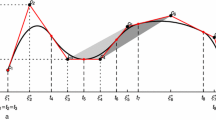Abstract
Given a point data set that contains several fairly unevenly distributed random points, this paper presents a new paradigm of curve interpolation to fit a curve to the data with end tangent vector constraints. The method uses a base curve, which is subjected to constrained shape manipulations to achieve interpolation, while maintaining end point and end tangent constraints. The algorithm is not sensitive to the distribution or to the randomness of the data, as long as the points represent fairly simple shapes, as in reverse engineering of properly segmented points, or in shape design using simple segments. The method is iterative in nature and allows various forms of adjustments to achieve good results.
Similar content being viewed by others
References
Benko P, Martin RR, Varady T (2001) Algorithms for reverse engineering boundary representation models. Comput Aided Geom Des 33:839–851
Chivate PN, Jablokow AG (1995) Review of surface representations and fitting for reverse engineering. Comput Integr Manuf Syst 8:193–204
De Boor C (1978) A practical guide to splines. Springer, Berlin Heidelberg New York
Dierckx P (1995) Curve and surface fitting with splines. Claredon, Oxford
Fang L, Gossard DC (1992) Fitting 3-D curves to unorganized points using deformable curves. In: Visual computing. Springer, Berlin Heidelberg New York, pp 535–543
Floater MS (1997) Parametrization and smooth approximation of surface triangulations. Comput Aided Geom Des 14:231–250
Floater MS, Reimers M (2001) Meshless parametrization and surface reconstruction. Comput Aided Geom Des 18:77–92
Fowler B, Bartels R (1993) Constraint-based curve manipulation. IEEE Comput Graph Appl 13:43–49
Greiner G, Hormann K (1997) Interpolating and approximating scattered 3-D data with hierarchical tensor product B-splines. In: Le Mehaute A, Rabut C, Schumaker LL (eds) Surface fitting and multiresolution methods Vanderbilt University Press, Nashville, TN, pp 163–172
Hoschek J, Dankwort W (eds) (1996) Reverse engineering. Teubner, Stuttgart
Kruth J-P, Kerstens A (1998) Reverse engineering modeling of free-form surfaces from point clouds subject to boundary conditions. J Mater Process Technol 76:120–127
Lane JM, Riesenfeld RF (1980) A theoretical development for the computer generation and display of piecewise polynomial surfaces. IEEE Transactions on Pattern Analysis and Machine Intelligence 2(1):35–46
Lee IK (2000) Curve reconstruction from unorganized points. Comput Aided Geom Des 17:161–177
Ma W, Kruth JP (1995) Parametrization of randomly measured points for least-squares fitting of B-spline curves and surfaces. Comput Aided Des 27:663–675
Ma W, Kruth J-P (1995) NURBS curve and surface fitting and interpolation. In: Daehlen M, Lyche T, Schumaker LL (eds) Mathematical methods for curves and surfaces. Vanderbilt University Press, Nashville, TN, pp 315–322
Manning JR (1974) Continuity conditions for spline curves. Comput J 17:181–186
Milroy MJ et al. (1995) G 1 continuity of B-spline surface patches in reverse engineering. Comput Aided Des 27:471–478
Piegl L, Tiller W (1997) The \(\mathcal{NURBS}\) Book, 2nd edn. Springer, Berlin Heidelberg New York
Sarkar B, Menq C (1991) Parameter optimization in approximating curves and surfaces to measurement data. Comput Aided Geom Des 8:267–290
Sarkar B, Menq C (1991) Smooth surface approximation and reverse engineering. Comput Aided Des 23:623–628
Varady T, Martin RR, Cox J (1997) Reverse engineering of geometric models - an introduction. Comput Aided Des 29:255–268
Weiss V et al. (2002) Advanced surface fitting techniques. Comput Aided Geom Des 19:19–42
Werner A et al. (1997) Reverse engineering of free-form surfaces. J Mater Process Technol 76:128–132
Author information
Authors and Affiliations
Corresponding author
Rights and permissions
About this article
Cite this article
Piegl, L., Ma, W. & Tiller, W. An alternative method of curve interpolation. Vis Comput 21, 104–117 (2005). https://doi.org/10.1007/s00371-004-0274-y
Published:
Issue Date:
DOI: https://doi.org/10.1007/s00371-004-0274-y



